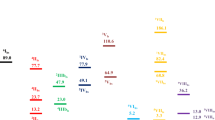Abstract
Coordination of dinitrogen to Sellmann-type iron (II) complexes in a sulfur-dominated coordination sphere, which emulates the environment of iron centers in the FeMo-cofactor of nitrogenase, is analyzed with respect to spin states, spin barriers, and the effect of trans-ligands. Such detailed investigations became only recently feasible when the reliability of density functional methods, which are the only quantum chemical methods capable of describing large transition metal complexes, could significantly be improved for the calculation of energies for states of different spin. It is found that the actual binding energy of dinitrogen is of sufficient magnitude for a reasonably strong fixation of N2 by Sellmann-type coordination compounds. However, potential fixation is determined by additional factors which reduce the binding energy. One factor is the change in spin state of the N2-free metal fragment, which lowers the total energy and quenches the thermodynamic stabilization effect of the binding energy. In addition, the metal fragment rearranges and gains even more stabilization energy for the un-coordinated state. Apart from these thermodynamical effects, the existence of spin barriers, which must be overcome upon binding of dinitrogen, leads to kinetical effects, which cannot be neglected.
Similar content being viewed by others
References
Leigh GJ (ed) (2002) Nitrogen fixation at the millenium. Elsevier, Amsterdam
Sellmann D, Sutter J (1996) J Biolog Inorg Chem 1:587–593
Sellmann D, Sutter J (1997) Acc Chem Res 30:460–469
Sellmann D, Sutter J (2000) Biological N2 fixation: molecular mechanism of the nitrogenase catalyzed N2 dependent HD-formation, the N2 fixation inhibition and the open-side FeMoco model. In: Trzeciak AM, Sobota D, Ziolkowski J (eds) Perspectives in coordination chemistry, vol. 5. University of Wroclaw, Poland
Sellmann D, Utz J, Blum N, Heinemann FW (1999) Coord Chem Rev 190–192:607–627
Yandulov DV, Schrock RR (2003) Science 301:76–78
Schrock RR (2003) Chem Comm 19:2389–2391
Leigh GJ (2003) Science 301:55–56
Einsle O, Tezcan FA, Andrade SLA, Schmid B, Yoshida M, Howard JB, Rees DC (2002) Science 297:1696–1700
Dance I (2003) Chem Comm 3:324–325
Hinnemann B, Nørskov JK (2003) J Am Chem Soc 125:1466–1467
Schimpl J, Petrilli HM, Blöchl PE (2003) J Am Chem Soc 125:15772–15778
Hinnemann B, Nørskov JK (2004) J Am Chem Soc 126:3920–3927
Reiher M, Hess BA (2004) Adv Inorg Chem 56:55–100
Reiher M, Kirchner B, Hutter J, Sellmann D, Hess BA (2004) Chem Eur J 10:4443–4453
Kirchner B, Reiher M, Hille A, Hutter J, Hess BA (2004) Chem Eur J (in press)
Sellmann D, Hautsch B, Rösler A, Heinemann FW (2001) Angew Chem 113:1553–1558
Sellmann D, Hautsch B, Rösler A, Heinemann FW (2001) Angew Chem Int Ed 40:1505–1507
Sellmann D, Hille A, Heinemann FW, Moll M, Brehm G, Reiher M, Hess BA, Schneider S (2003) Inorg Chim Acta 348:194–198
Sellmann D, Hille A, Rösler A, Heinemann FW, Moll M, Brehm G, Schneider S, Reiher M, Hess BA, Bauer W (2003) Chem Eur J 10:819–830
Reiher M, Hess BA (2002) Chem Eur J 8:5332–5339
Deng L, Margl P, Ziegler T (1999) J Am Chem Soc 121:6479–6487
Ghosh A, Vangberg T, Gonzalez E, Taylor P (2001) J Porph Phthalocyan 5:345–356
Paulsen H, Duelund L, Winkler H, Toftlund H, Trautwein AX (2001) Inorg Chem 40:2201–2203
Reiher M, Salomon O, Hess BA (2001) Theor Chem Acc 107:48–55
Reiher M, Salomon O, Sellmann D, Hess BA (2001) Chem Eur J 7:5195–5202
Becke AD (1993) J Chem Phys 98:5648–5652
Stephens PJ, Devlin FJ, Chabalowski CF, Frisch MJ (1994) J Phys Chem 98:11623–11627
Reiher M (2002) Inorg Chem 41:6928–6935
Salomon O, Reiher M, Hess BA (2002) J Chem Phys 117:4729–4737
Franke O, Wiesler BE, Lehnert N, Näther C, Ksenofontov V, Neuhausen J, Tuczek F (2002) Inorg Chem 41:3491–3499
Keogh DW, Poli R (1997) J Am Chem Soc 119:2516–2523
Becke AD (1988) Phys Rev A 38: 3098-3100
Perdew JP (1986) Phys Rev B 33:8822–8824
Koch W, Holthausen MC (2000) A chemist's guide to density functional theory. Wiley-VCH, Weinheim
Ahlrichs R, Bär M, Häser M, Horn H, Kölmel C (1989) Chem Phys Lett 162:165–169
Eichkorn K, Treutler O, Öhm H, Häser M, Ahlrichs R (1995) Chem Phys Lett 240:283–290
Eichkorn K, Weigend F, Treutler O, Ahlrichs R (1997) Theor Chem Acc 97:119–124
Schäfer A, Huber C, Ahlrichs R (1994) J Chem Phys 100:5829
Neugebauer J, Reiher M, Kind C, Hess BA (2002) J Comput Chem 23:895–910
Davidson ER (1967) J Chem Phys 46:3320–3324
Roby KR (1974) Mol Phys 27:81–104
Heinzmann R, Ahlrichs R (1976) Theoret Chim Acta 42:33–45
Schaftenaar G, Noordik JH (2000) J Comput-Aided Mol Design 14:123–134
Kind C (2000) Rotcurve –- A program for the computation of reaction coordinates, University of Erlangen-Nuremberg: (unpublished)
Boys SF, Bernardi F (1970) Mol Phys 19:553–566
van Duijneveldt FB, van Duijenveldt-van de Rijdt JGCM, van Lenthe JH (1994) Chem Rev 94:1873
Sellmann D, Soglowek W, Knoch F, Moll M (1989) Angew Chem 101:1244–1245
Sellmann D, Soglowek W, Knoch F, Moll M (1989) Angew Chem 28:1271–1272
Author information
Authors and Affiliations
Corresponding author
Rights and permissions
About this article
Cite this article
Moritz, G., Reiher, M. & Hess, B. Analysis of spin states, spin barriers, and trans-effects involved in the coordination and stabilization of dinitrogen by biomimetic iron complexes. Theor Chem Acc 114, 76–83 (2005). https://doi.org/10.1007/s00214-005-0646-z
Received:
Accepted:
Published:
Issue Date:
DOI: https://doi.org/10.1007/s00214-005-0646-z




